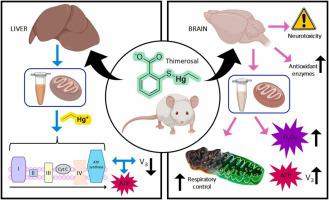当前位置:
X-MOL 学术
›
J. Trace Elem. Med. Bio.
›
论文详情
Our official English website, www.x-mol.net, welcomes your feedback! (Note: you will need to create a separate account there.)
Does acute exposure to thimerosal, an organic mercury compound, affect the mitochondrial function of an infant model?
Journal of Trace Elements in Medicine and Biology ( IF 3.5 ) Pub Date : 2024-01-22 , DOI: 10.1016/j.jtemb.2024.127399 Marcos V.S. Sales , Ellen dos Santos Silva Barros , Rafael D.S. Azevedo , Francisco A.S. Cunha , Josué Carinhanha C. Santos , Ana C.R. Leite
Journal of Trace Elements in Medicine and Biology ( IF 3.5 ) Pub Date : 2024-01-22 , DOI: 10.1016/j.jtemb.2024.127399 Marcos V.S. Sales , Ellen dos Santos Silva Barros , Rafael D.S. Azevedo , Francisco A.S. Cunha , Josué Carinhanha C. Santos , Ana C.R. Leite

|
Thimerosal (TM) is a toxic, organometallic mercury compound (which releases ethyl-mercury-containing compounds in aqueous solutions) used as a preservative in vaccines. Mitochondria are organelle which are highly vulnerable to many chemical compounds, including mercury (Hg) and its derivatives. Wistar rats (at 21 days of age) were used to model a child’s TM exposure following childhood vaccination, divided in two groups: TM exposed (20 μg/kg/day) and unexposed controls (saline solution), both for 24 h. Atomic Fluorescence Spectrometry was used to quantify the amounts of mercury in tissues. The electron transport chain (ETC) from isolated mitochondria was evaluated using an oxygen electrode. The mitochondrial membrane potential and HO production were analyzed using selective fluorescence probes. The activity of some enzymes (SOD, CAT, GPx, and AChE) and secondary markers of oxidative stress (GSH, GSSG, total free thiol) were also examined in tissues. Hg accumulation in the brain and liver was higher in exposed animals when compared to the control. Liver-isolated mitochondria showed that TM improved respiratory control by 23%; however, states 3 and 4 of the ETC presented a decrease of 16% and 37%, respectively. Furthermore, brain-isolated mitochondria presented an improvement of 61% in respiratory control. Brain enzyme activities were significantly impacted in TM-exposed rats compared to unexposed rats as follows: decreases in SOD (32%) and AChE (42%) and increases in GPx (79%) and CAT (100%). GPx enzyme activity in the liver was significantly increased (37%). Among secondary oxidative stress markers, the brain’s total reduced thiol (SH) concentration was significantly increased (41%). Acute TM treatment exposure in a Wistar rat model mimicking TM exposure in an infant following childhood vaccination significantly damaged brain bioenergetic pathways. This study supports the ability of TM exposure to preferentially damage the nervous system.
中文翻译:

急性接触硫柳汞(一种有机汞化合物)是否会影响婴儿模型的线粒体功能?
硫柳汞 (TM) 是一种有毒的有机金属汞化合物(在水溶液中释放出含乙基汞的化合物),用作疫苗中的防腐剂。线粒体是一种非常容易受到许多化学化合物影响的细胞器,包括汞 (Hg) 及其衍生物。Wistar 大鼠(21 天龄)用于模拟儿童接种疫苗后的 TM 暴露,分为两组:TM 暴露组(20 μg/kg/天)和未暴露对照组(盐水溶液),均持续 24 小时。原子荧光光谱法用于量化组织中的汞含量。使用氧电极评估来自分离线粒体的电子传递链(ETC)。使用选择性荧光探针分析线粒体膜电位和 H2O 产生。还检查了组织中一些酶(SOD、CAT、GPx 和 AChE)的活性以及氧化应激的次要标志物(GSH、GSSG、总游离硫醇)。与对照组相比,暴露动物大脑和肝脏中的汞积累量更高。肝脏分离的线粒体显示 TM 将呼吸控制改善了 23%;然而,ETC 的状态 3 和状态 4 分别下降了 16% 和 37%。此外,脑分离线粒体的呼吸控制能力提高了 61%。与未暴露的大鼠相比,暴露于TM的大鼠的脑酶活性受到显着影响,具体如下:SOD(32%)和AChE(42%)降低,GPx(79%)和CAT(100%)增加。肝脏中的 GPx 酶活性显着增加(37%)。在次要氧化应激标志物中,大脑总还原硫醇 (SH) 浓度显着增加 (41%)。Wistar 大鼠模型中的急性 TM 治疗暴露(模拟儿童时期接种疫苗后婴儿的 TM 暴露)显着损害了大脑生物能通路。这项研究支持了 TM 暴露能够优先损害神经系统。
更新日期:2024-01-22
中文翻译:

急性接触硫柳汞(一种有机汞化合物)是否会影响婴儿模型的线粒体功能?
硫柳汞 (TM) 是一种有毒的有机金属汞化合物(在水溶液中释放出含乙基汞的化合物),用作疫苗中的防腐剂。线粒体是一种非常容易受到许多化学化合物影响的细胞器,包括汞 (Hg) 及其衍生物。Wistar 大鼠(21 天龄)用于模拟儿童接种疫苗后的 TM 暴露,分为两组:TM 暴露组(20 μg/kg/天)和未暴露对照组(盐水溶液),均持续 24 小时。原子荧光光谱法用于量化组织中的汞含量。使用氧电极评估来自分离线粒体的电子传递链(ETC)。使用选择性荧光探针分析线粒体膜电位和 H2O 产生。还检查了组织中一些酶(SOD、CAT、GPx 和 AChE)的活性以及氧化应激的次要标志物(GSH、GSSG、总游离硫醇)。与对照组相比,暴露动物大脑和肝脏中的汞积累量更高。肝脏分离的线粒体显示 TM 将呼吸控制改善了 23%;然而,ETC 的状态 3 和状态 4 分别下降了 16% 和 37%。此外,脑分离线粒体的呼吸控制能力提高了 61%。与未暴露的大鼠相比,暴露于TM的大鼠的脑酶活性受到显着影响,具体如下:SOD(32%)和AChE(42%)降低,GPx(79%)和CAT(100%)增加。肝脏中的 GPx 酶活性显着增加(37%)。在次要氧化应激标志物中,大脑总还原硫醇 (SH) 浓度显着增加 (41%)。Wistar 大鼠模型中的急性 TM 治疗暴露(模拟儿童时期接种疫苗后婴儿的 TM 暴露)显着损害了大脑生物能通路。这项研究支持了 TM 暴露能够优先损害神经系统。



























 京公网安备 11010802027423号
京公网安备 11010802027423号